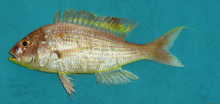Cucullanorhynchus is a monotypic genus of acanthocephalans. It contains a single species, Cucullanorhynchus constrictruncatus, which infests leopards in Vietnam.
Tchadorhynchus is a monotypic genus of acanthocephalans. It contains a single species, Tchadorhynchus quentini, which infests hyenas in Chad.
Multisentis is a monotypic genus of acanthocephalans. It contains a single species, Multisentis myrmecobius , parasite of the numbat from which it derives its species name. It was found in south-western Australia.
Floridosentis is a genus in Acanthocephala.
Tanaorhamphus is a monotypic genus of acanthocephalans containing a single species, Tanaorhamphus longirostris, that infests animals.
Eocollis is a genus in Acanthocephala.
Golvanacanthus is a monotypic genus of acanthocephalans containing a single species, Golvanacanthus blennii, that infests animals.
Machadosentis is a monotypic genus of acanthocephalans containing a single species, Machadosentis travassosi, that infests animals.
Triaspiron is a monotypic genus of acanthocephalans containing a single species, Triaspiron aphanii.
Caballerorhynchus is a monotypic genus of acanthocephalans containing a single species, Caballerorhynchus lamothei, that infests animals.
Gracilisentis is a genus in Acanthocephala.
Pandosentis is a genus in Acanthocephala.
Wolffhugelia is a monotypic genus of acanthocephalans containing a single species, Wolffhugelia matercula, that infests animals.
Microsentis is a monotypic genus of worms belonging to the family Neoechinorhynchidae.
Dispiron is a genus in Acanthocephala belonging to the family Neoechinorhynchidae.
Hexaspiron is a genus in Acanthocephala belonging to the family Neoechinorhynchidae.
Gorytocephalus is a genus in Acanthocephala belonging to the family Neoechinorhynchidae.
Octospiniferoides is a genus in Acanthocephala belonging to the family Neoechinorhynchidae.
Acanthodelta is a genus of acanthocephalan.
Paraechinorhynchus is a monotypic genus of acanthocephalans containing a single species, Paraechinorhynchus kalriai, that infests the rohu.

